Mussels are an easy appetizer or main dish for any night of the week. This quick preparation of creamy, Thai curry mussels in a coconut broth takes just 15 minutes to cook. Save time by using a store bought curry paste and a can of coconut milk to make this restaurant favorite at home.

This recipe really works well when mussels are on sale and you need a quick cooking meal for lunch or dinner.
Side dishes that work really well with these mussels are a Thai pomelo salad, Asian tomato salad, or winged bean salad if you can find winged beans.
Jump to:
Why You'll Like this Recipe
- From high end to mom and pop restaurants, Thai curry mussels are a fan favorite dish that everyone can share as an appetizer or enjoy as a main dish.
- After the mussels are cleaned, it just takes about 5-8 minutes to cook on the stovetop.
- A premade curry paste does most of the work providing the flavor in this dish, so you don't have to pound one from scratch.
Ingredients

- Mussels - Always buy mussels from a reputable supplier and cook them as soon after purchase. I purchased the mussels in the picture from costco and cooked them within 2 days of purchasing. They start to die if not stored properly, and you should not be cooking or eating dead mussels. (See Mussel Cooking Basics below for more tips). Mussels also come in a range of sizes from 1 inch to 3 inches long. You'll just need to cook them a little longer, if they're larger.
- Curry paste - Use a premade curry paste such as the yellow curry paste from Mae Ploy or another color curry paste of your choice. (They coincidentally most come in the same colors as traffic lights: green, yellow, and red.) For seafood, green and yellow work particularly well. Red curry paste, on the other hand, is spiked with chiles and usually cooked with red meat.
- Coconut milk (unsweetened)- Regular or light coconut milk works in this recipe. This is the distinct ingredient found in most Thai curries (with some notable exceptions like jungle curry). The sweet creaminess of the coconut, balances out the spicy, punchy, salty curry paste. The thickness of the milk really varies quite a bit from brand to brand. The Chaokoh brand tends to be the thickest version with other brands being notably more watery.
- Vegetable stock - If your coconut milk is really thick, you will need some extra liquid to thin it out. Water works too, but veg stock adds more flavor.
- Ginger and garlic - You really need some aromatic vegetables to freshen up the premade curry paste that's been sitting on the store shelf. Ginger goes so well with fresh seafood and garlic adds a grounding, earthy element to the sea flavor. If you have fresh lemongrass, that would be amazing too. Just finely chop up and add at the same time as the garlic and ginger.
- Coconut sugar - Or brown sugar works too. Some Thai restaurants add a lot of sugar to balance out the intense curry paste. By making it at home, you get to control the amount of sweetness. Add more or less to your taste. Palm sugar is the traditional sweetener used in Thailand, but it's not so easy to find in the regular supermarket.
- Cooking Oil - You'll need just a dab to fry the curry paste. You could also use the hardened coconut cream from the can of coconut milk.
- Turmeric powder (optional) – You don’t have to add this. but it gives the curry an extra, bright yellow color and some added health benefits.
See recipe card for quantities.
Optional Garnishes
- Lime wedges - A squeeze of fresh lime juice adds so much pop and freshness to these mussels. And fresh citrus wedges are nearly a requirement with most seafood dishes (except those cooked with lots of tomato).
- Cilantro sprigs - Or green onion works too. Aside from the bright green color, they add to the aroma when mixed with the hot broth.
Which Curry Paste should you buy?
Consider these 2 store brands, both products of Thailand and no artificial ingredients.
- The expensive one by Thai Kitchen contains less salt and fewer ingredients: chile, garlic, lemongrass, galangal, salt, shallot, spices, kaffir lime.
- The less expensive one by Mae Ploy has as much flavor (if not more) but more salt that acts as a preservative. This brand contains the following ingredients: garlic, lemongrass, salt, shallot, galangal, dried red chili, coriander seed, kaffir lime peel, curry powder, cumin, cinnamon, turmeric, cinnamon, nutmeg.
Note that the Mae Ploy brand tends to be salty, and thus requires less additional salt I've found the Thai Kitchen brand not salty at all and requires double the salt or fish sauce.
Both brands do not have artificial preservatives or additives, so they both make a great choice.
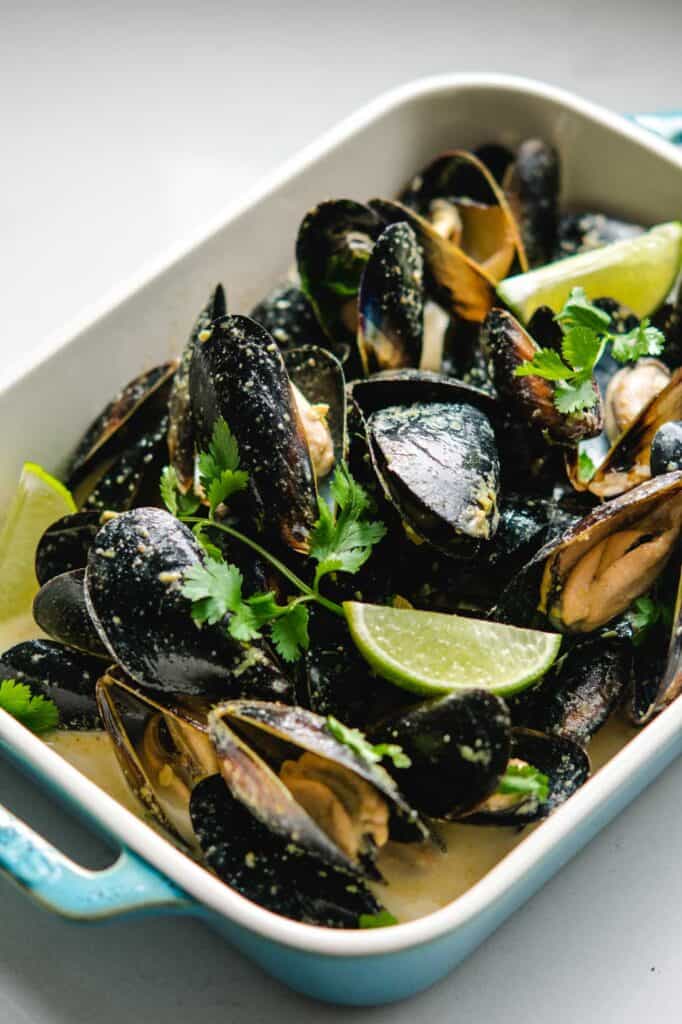
Mussel Cooking Basics
How do you clean mussels?
Clean shaven is better. Rip off the hairy, beard, if there. It will cause the mussel to die. Once you take off the beard, you need to cook it right away.
If the mussel is open and won’t close when you tap it, it’s dead and time to discard.
Give them a wash and scrub, if you have it in you. Mussels are often farmed, and if so, they won’t contain as much grit that needs be purged out prior to cooking as with clams.
How do you store mussels before using?
You should consume mussels as close to purchase as possible. They will die, and you want to cook them alive. (Poor mussels.)
If you must store them, cover them loosely with a wet towel to keep them moist. Store on ice if possible, in the fridge.
Bonus: Dinner Table Mussel Trivia
Did you ever notice that some mussel meat is colored white and some coral?
It actually relates to their sex. Males are plain white, and females come in various shades of salmon.
Though different in hue, they are equal in taste.
Instructions
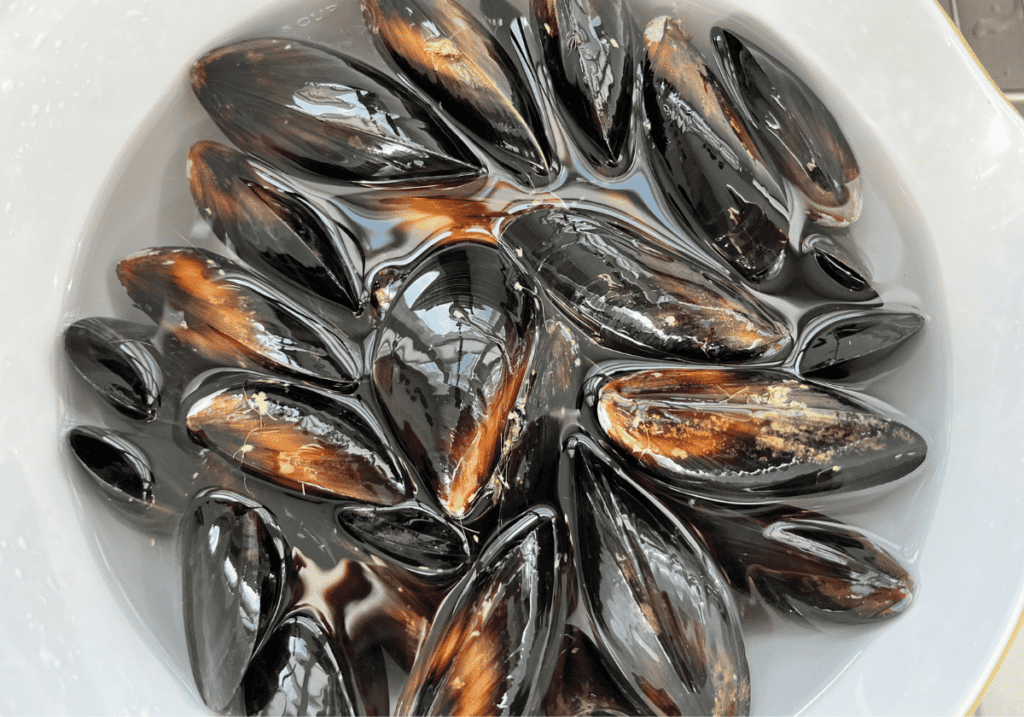
Pull off the beards of the mussels and wash thoroughly in water to remove any dirt.

Heat the oil over medium heat in at pot (at least 3 qt size). Add the curry paste, garlic, and ginger.
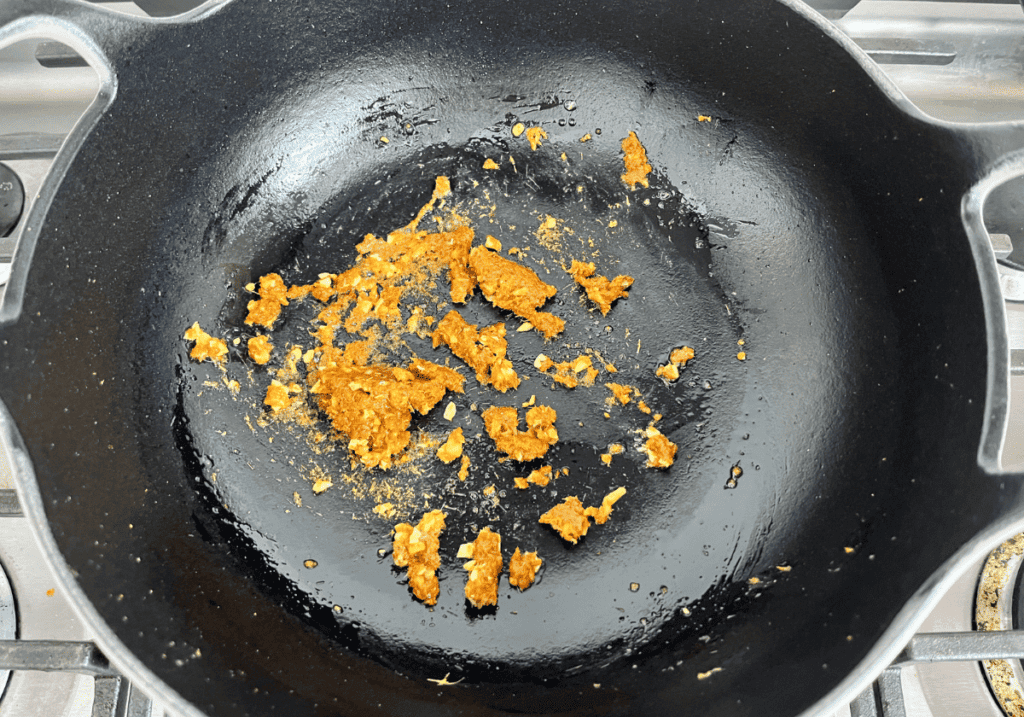
Stir fry for about a minute to bloom the flavors.
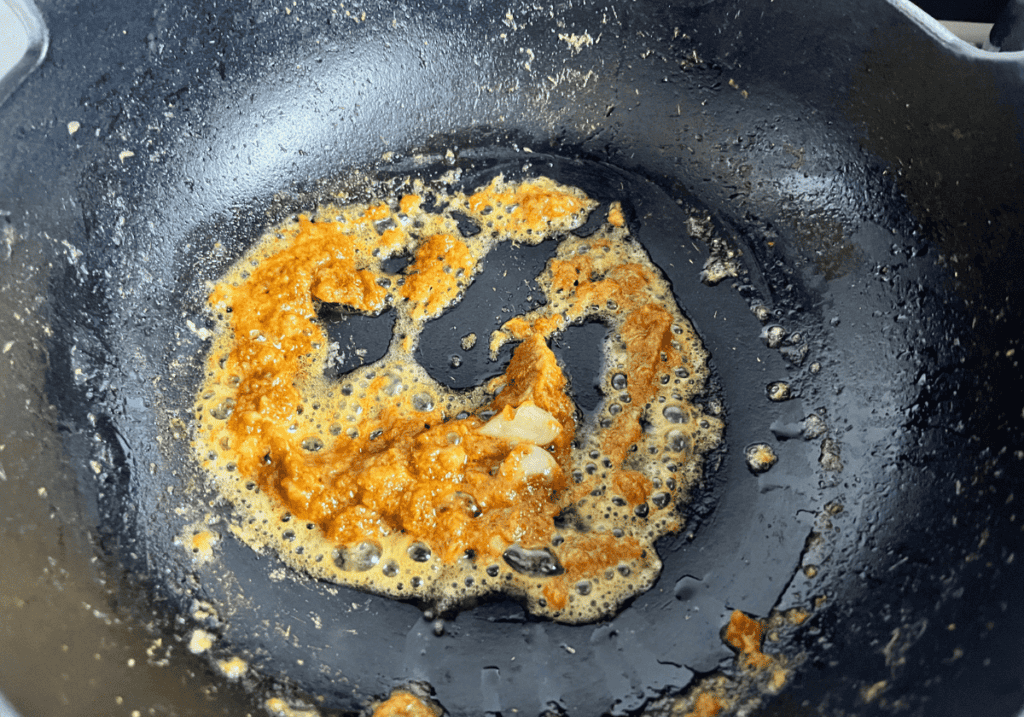
I like to add the hardened fat from the coconut milk to give the curry paste some extra fat to fry in.

Add the coconut milk, sugar, and fish sauce to pot.
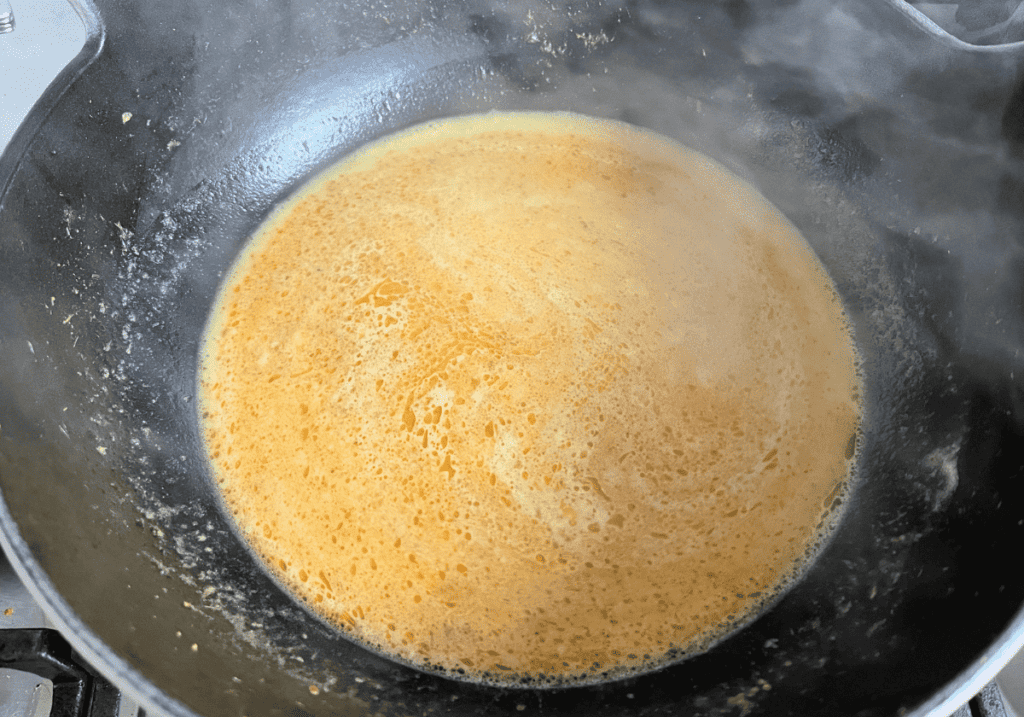
Add the turmeric if using. You can see it really adds a nice yellow color to the broth. Taste the broth and add more salt or sugar as needed.

Add the cleaned and drained mussels. Bring to a simmer (low bubble) over medium high heat. Cover, lower the heat to medium, and cook for 5-8 minutes, depending on the size of the mussels. Stir every 2-3 minutes to make sure the mussels get equal access to the hot liquid.
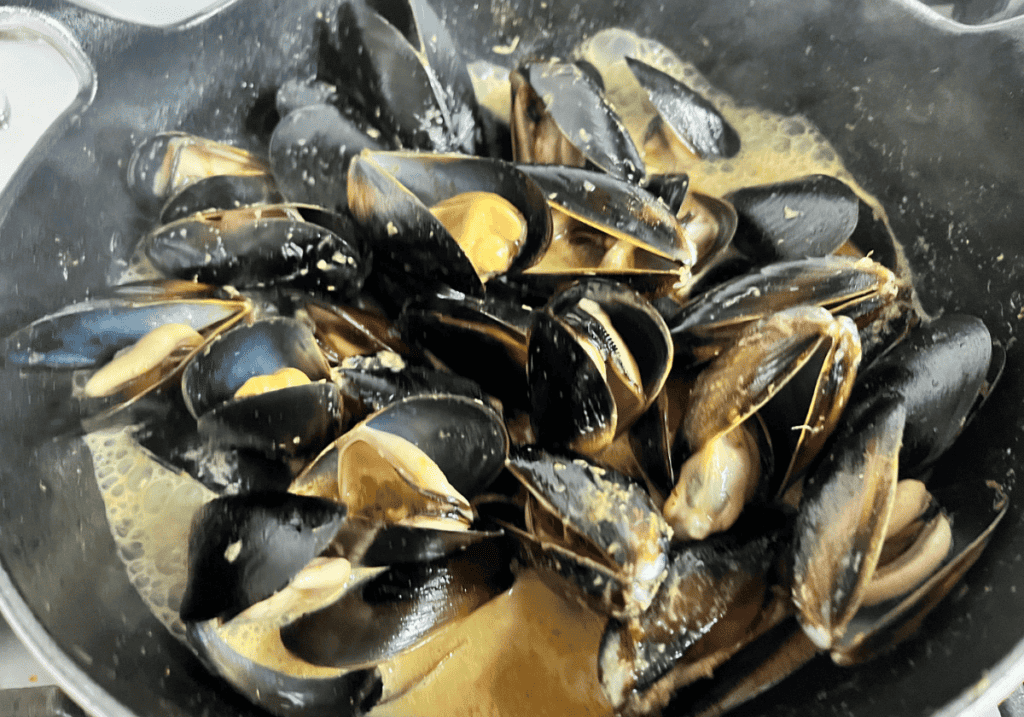
The mussels are cooked once they have opened. Discard any mussels that did not open. Serve hot.
Hint: There is a fine line between overcooked mussels and undercooked mussels. Even if they have opened, give them another minute or two, or they can taste a bit soft.
They are “overcooked” when the mussel detaches from the shell and ends up in the pot. They also get a little but rubbery. Not the end of the world, but then you have a to pick through more empty shells.
Substitutions
- Shrimp - You could easily substitute peeled, defrosted shrimp for the mussels.
- Halibut - A firm fleshed fish that holds together well in a broth, like halibut, could also work well instead of mussels.
- Tofu - Substitute fried cubes of tofu or other firm vegetables, such as pumpkins, green beans, or even eggplant instead of mussels.
- Vegetarian - This recipe uses fish sauce. Sub with soy sauce or tamari.
For a vegan Thai curry, check out this recipe for a vegan Thai butternut squash curry.

Variations
- Noodle Soup - You could serve this with rice or hunks of bread to sop up that sauce. My favorite starch to eat with this though are brown rice noodles. Just cook them according to the package and drop them in the serving bowl with the mussels. They soak up all that flavor of the coconut curry broth.
- Potatoes - Another carbohydrate option instead of rice, bread, and noodles are cooked large chunks of potatoes. Add them in towards the end of cooking to heat through. They take much longer to cook than the mussels, so I would just boil them in salt separately.
- Spicy - Did you want to feel the burn? Add some fresh chopped jalapeños, habanero or other chili to the pot with the curry paste. A dried, ground spice like cayenne pepper would work too or Italian red peperoncini flakes.

Equipment
- 3 qt saucepan or larger with a lid to cover
- Heatsafe stirring utensil
- Cutting board and knife
- Large bowl to wash the mussels.
Storage
Store up to 3 days in the fridge in an airtight container.
You could freeze this in an airtight container for up to 1 month. It might seem odd to freeze the cooked mussel shells, but i've tried it with great results. It defrosted just fine and the quality of the mussels and broth was very similar to when I had it freshly cooked.
Helpful Tips
- Cook mussels as soon as possible after purchasing. As my fishmonger says, "You do not want to mess around with shellfish." They die quickly. Store in the fridge and cover lightly with a damp cloth or paper towel to keep them from drying out.
- Using a store bought curry paste saves time, but they also very widely in saltiness. I used the Mae Ploy brand which tends to be salty, and thus requires less additional salt/tamari. I've found the Thai Kitchen brand to be not salty at all and requires double the addition of salt or tamari. Adjust to your level of saltiness by tasting the broth before adding the mussels. Add more fish sauce or salt as needed.
- Similarly, adjust the sweetness to your liking. This recipe does not use much sugar, and the result is not very sweet but more like a hint of sweetness to balance out the spices in the curry paste. Add more sugar to the broth before adding the mussels if that is what you prefer.
- If you continue to cook the mussels too long after they've opened, they will overcook, start shrinking, and falling off the shell. Take care not to leave the pot to avoid overcooking.
- If you prefer to dump everything in a pot all at once, that will work too. Stir frying the curry paste and aromatic vegetables separately just adds a little more nuance and develops more distinct flavors.
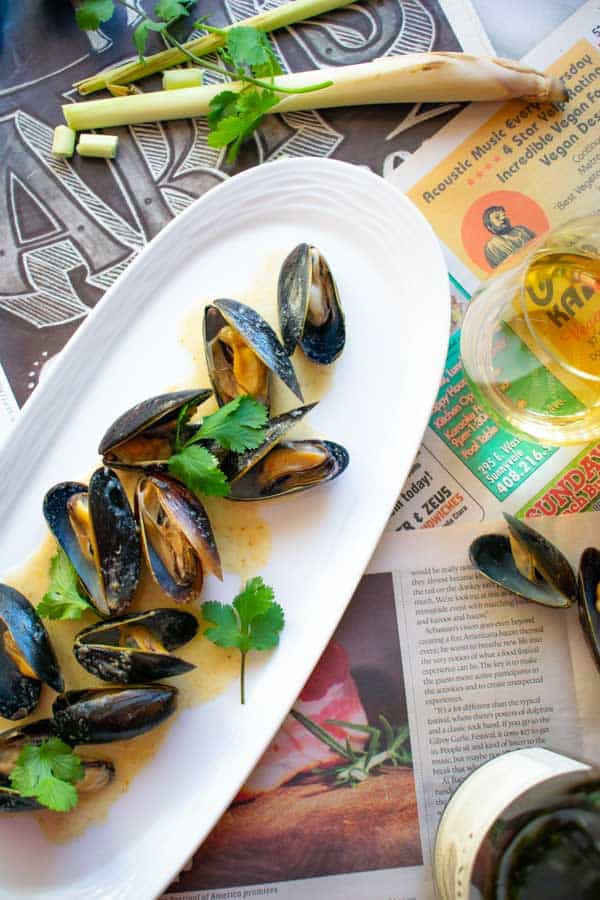
FAQ
The difference is the type of different type of ingredients that are smashed into the curry base of lemongrass, garlic, shallot, galangal, and cilantro root to name a few of the ingredients. Yellow curry paste has the addition of turmeric, which makes it yellow. Red curry paste has dried red chiles ground into the paste. Green curry paste has lots of fresh herbs like cilantro and makrut limes.
If a regular curry is Indian curry, Indian curries typically use water or dairy in their curry broth and little if any sugar. Thai curries typically use coconut milk and sugar to balance out the spice and heat of the curry paste.
It can be either depending on where you buy it from and who made it. I've found Thai curries in Thailand to be screaming spicy while Thai curries in American restaurants can range from slightly to cloyingly sweet. It all depends on how much chili and sugar the cook decides to add.
Related Seafood Recipes
- 17 Thanksgiving Seafood Ideas to Add to Your Holiday Menu
- Quick Pan Seared Sockeye Salmon (with a savory rub)
- Blackened Tuna Steaks (3 ingredients, 15 minutes)
- The BEST Ceviche Recipe (with regular ingredients)
Other Recipes wit Coconut Milk
Recipe
Foolproof Thai Curry Mussels with Coconut Milk
Ingredients
- 1 ½ lb mussels washed and debearded, see Note 1
- 1 Tb oil
- 1 Tb yellow curry paste or curry paste of your choice, see Note 2
- 1 teaspoon garlic minced
- 1 teaspoon ginger and/or fresh lemongrass bulb minced, optional
- 1 can coconut milk (13.5-14oz) or light coconut milk
- 2 teaspoon coconut sugar or 1 teaspoon brown sugar, see Note 3
- 1 teaspoon fish sauce
- ¼ teaspoon ground turmeric optional
Garnish
- lime wedges
- cilantro sprigs or sliced green onion
Instructions
- Heat the oil over medium heat in at pot.
- Add the curry paste, garlic, and ginger.Stir fry for about 30 seconds to a minute to bloom the flavors. I like to add the hardened fat from the coconut milk to give the curry paste some extra fat to fry in.
- Add the coconut milk, sugar, and fish sauce to pot. Add turmerid if using.
- Add the cleaned and drained mussels. Bring to a simmer (low bubble) over medium high heat. Cover, lower the heat to medium, and cook for 5-8 minutes, depending on the size of the mussels. Stir every 2-3 minutes to make sure the mussels get equal access to the hot liquid.
- The mussels are cooked once they have opened. Discard any mussels that did not open.
- Serve hot. Garnish with fresh lime wedges and cilantro.
Notes
-
- Cook mussels as soon as possible after purchasing. As my fishmonger says, "You do not want to mess around with shellfish." They die quickly. Store in the fridge and cover lightly with a damp cloth or paper towel to keep them from drying out.
- Using a store bought curry paste saves time, but they also very widely in saltiness. I used the Mae Ploy brand which tends to be salty, and thus requires less additional salt/tamari. I've found the Thai Kitchen brand to be not salty at all and requires double the addition of salt or tamari. Adjust to your level of saltiness by tasting the broth before adding the mussels. Add more fish sauce or salt as needed.
- Similarly, adjust the sweetness to your liking. This recipe does not use much sugar, and the result is not very sweet but more like a hint of sweetness to balance out the spices in the curry paste. Add more sugar to the broth before adding the mussels if that is what you prefer.
- If you continue to cook the mussels too long after they've opened, they will overcook, start shrinking, and falling off the shell. Take care not to leave the pot to avoid overcooking.
- If you prefer to dump everything in a pot all at once, that will work too. Stir frying the curry paste and aromatic vegetables separately just adds a little more nuance and develops more distinct flavors.
Nutrition
Food safety
- Do not use the same utensils on cooked food, that previously touched raw meat.
- Don't leave food sitting out at room temperature for extended periods.
- Never leave food that is still cooking unattended.
- Use oils with high smoking point to avoid harmful compounds.
- Always have good ventilation when using a gas stove.
See more guidelines at USDA.gov.
Fortune Cookie 🥠
Both healthy and unhealthy behaviors are contagious.
Psychologist, Dr. Ellen Hendriksen
Lucky Cat 🍀 🐈

I am allowed to rest while building my dreams.



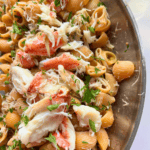


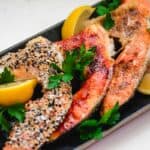
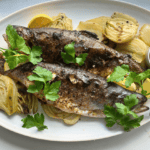
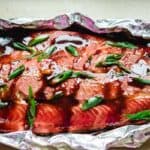
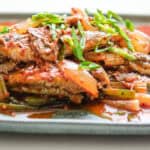


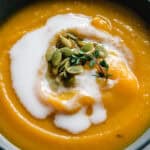
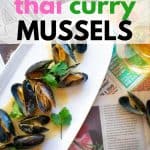
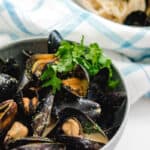
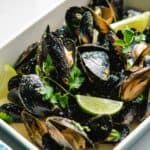





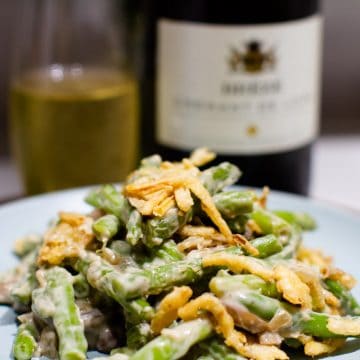





casey markee says
Not a fan of seafood but I would absolutely change for this one. Thanks!